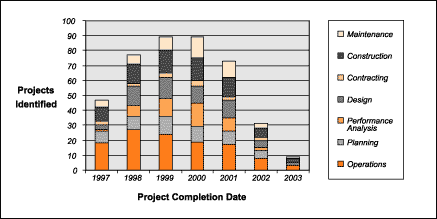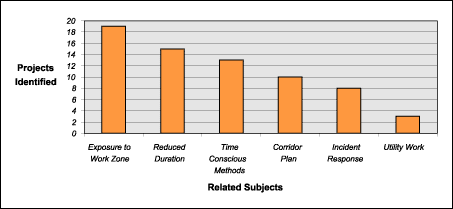Fact Sheet 7 - Compendium of Work Zone Research, Development, and Technology Transfer
Summer 2002
Numerous transportation agencies and research groups are conducting research projects and activities that have applications to improving mobility and safety in work zones. To capture these efforts, the Federal Highway Administration (FHWA) has developed an easily accessible compendium of information on recent work zone-related research, development, and technology transfer. The Compendium is a database that provides users with valuable information on other work zone-related efforts and can support personnel in making informed choices about the allocation of funds for future research and projects.
Approach
FHWA identified recent and ongoing projects (1997 to present) related to work zone mobility and safety through literature reviews, Web site searches, attendance at research presentations, and interviews conducted within FHWA and with other transportation agency and research personnel. Through these efforts, FHWA identified 332 projects. Each project was documented using a standard database utility. Projects were then classified based on their applicability to different phases of work zone activity (e.g., design, operations) and related subject areas (e.g., worker safety, traffic management). The database compendium of projects provides users with the capability to conduct keyword searches and generate reports.
Information Included for Each Project
For each project, the compendium includes:
- Basic project identifying information
- Format of information
- Relevant phases of work zone activity
- Related subject categories.
Basic project identifying information covers title, description, contributing agency, performing agency, completion year, point of contact, and source of information.
Findings
Figure 1 shows the breakout of projects, identified by year and phase of activity. This figure illustrates three main findings:
Figure 1 — Number of projects identified by year and phase of activity.
- The majority of identified projects for each year relate to work
zone operations; this is not surprising as operations is a broad category
that covers many topics listed under related subjects.
- In the year 2000, the number of projects related to performance
analysis of work zones increased compared to previous years.
- Projects identified related to maintenance also achieved significant relative growth during the year 2000.
Each project was reviewed to identify all of the reasonably applicable subjects from a classification system. Figure 2 shows the related subject categories with the greatest number of projects identified. Many projects transcended several related subject categories. The subject with the most related projects was traffic management (166). As a growing proportion of work zone activity is now performed under traffic conditions, traffic management is clearly an important aspect of work zone safety and mobility. Figure 3 shows the related subject categories with the fewest projects identified. The utility work category received the fewest entries during the synthesis, with only three projects identified.
Figure 2 — Related subject categories with greater than 40 projects identified.
Implications
As similar research efforts are being performed simultaneously, it is likely efforts are being duplicated. Further review of existing research efforts could lead to conclusions drawn from the collective efforts that may help support better decisions both on how to spend limited research budgets and what practices to implement. This is one tool that transportation agencies can use to help maximize their overall efforts related to work zones, and ultimately improve the quality of services — safety and mobility — for travelers and workers during construction and reconstruction efforts.
Figure 3 — Related subject categories with less than 20 projects identified.
Receiving a Copy of the Compendium
The Compendium is available in CD-ROM format. To obtain a copy of the CD-ROM, e-mail a request to WorkZoneFeedback@dot.gov. Indicate your name, mailing address, zip code, telephone number and your e-mail address and the publication you are requesting. Other publications available include the "Work Zone Best Practices Guidebook".
To learn more, contact:
Jim Sorenson
Federal Highway Administration
400 Seventh Street, S.W.
Washington, DC 20590
Phone: 202-366-1333
Email: James.Sorenson@fhwa.dot.gov
Tracy Scriba
Federal Highway Administration
400 Seventh Street, S.W.
Washington, DC 20590
Phone: 202-366-0855
Email: Tracy.Scriba@fhwa.dot.gov
Deborah Curtis
QuickZone Liaison
Federal Highway Administration
6300 Georgetown Pike
McLean, VA 22101-2296
Phone: 202-493-3267
Email: Deborah.Curtis@fhwa.dot.gov
U.S. Department of Transportation
Federal Highway Administration
Publication No. FHWA-OP-02-054



